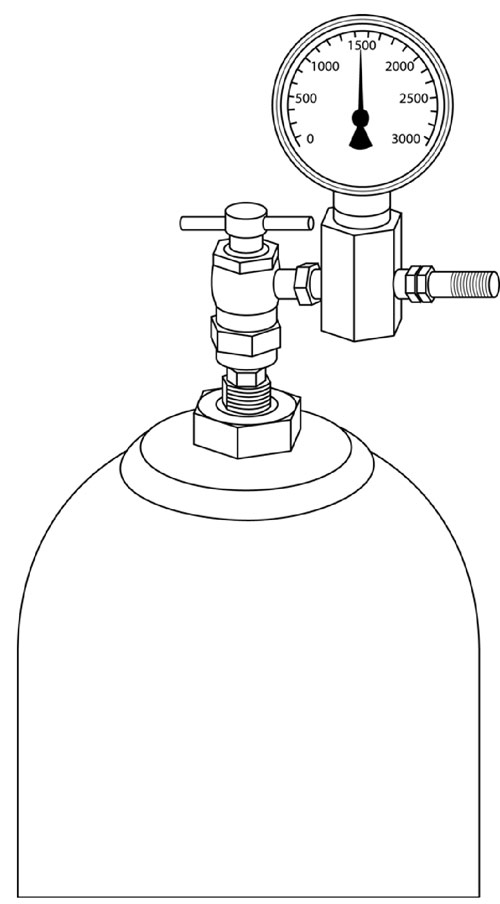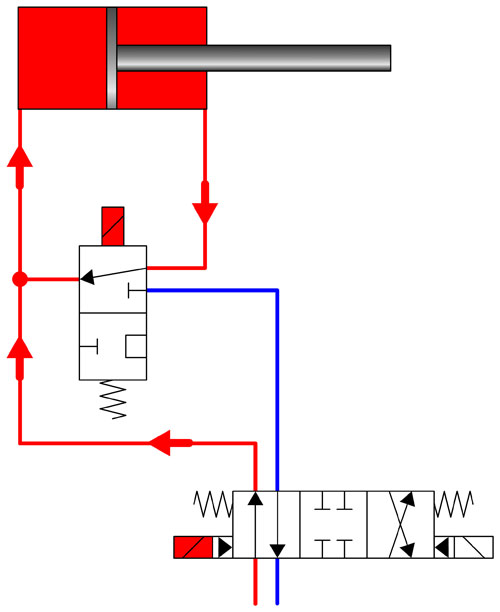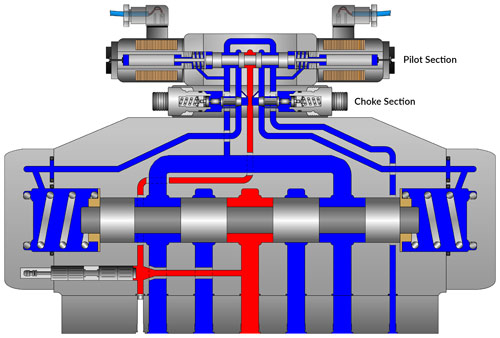Understanding the complex components and systems that make up high-speed industrial hydraulics is critical to well-maintained, efficient machines.
By Carl Dyke, Contributing Editor
Control surfaces on the wings of aircraft have to move into position very quickly. Aerobatic or military aircraft pilots may choose to maneuver through the three axes of roll, pitch and yaw simultaneously. A sudden change in flight path may require snap-action aileron, elevator and rudder positioning, against an opposing rush of air.
In a lumber mill where heavy logs and massive timbers must be moved into precise position quickly for the next stage of milling, similar fast motions are required. In some cases it’s the heavy cutterhead of the machine that must be moved quickly into a very precise position. Pneumatics won’t work for these applications due to the high forces and therefore the high pressures required in the relatively small diameter cylinders.
In some manufacturing applications such as a composite panel board plant, a hydraulic hoist table is lowered slowly, one layer at a time as product is added to the top of a heavy stack. When the stack is complete and has been moved to the next department, the unloaded hoist is shuttled all the way back to the top at high speed to start building the next stack. While not a precise positioning application, this machine needs high flow rates.
These are a few examples of high-speed industrial hydraulics systems. Let’s examine some of the unique components and design parameters that accompany these systems and the basic maintenance requirements.
Pump size
Pumps don’t always need to be sized for the maximum system flow rate. In high flow applications such as positioning cylinders in a sawmill, or in any plant where heavy materials or machine slides need to be moved quickly, the pump can often be sized for average flow rates or just slightly higher.
With flow and directional valves open for only short durations within the larger machine cycle, an accumulator can supplement the pump and make up the needed flow rates. In fact, the decompressing gas precharge in the accumulator can offer some acceleration to the rate of hydraulic flow that the pump cannot.
In the case of the unloaded stack hoist being returned quickly to the upper starting position, the simple trick of flow regeneration avoids the need for a large pump or an accumulator. Regeneration which routes the flow from the rod-end port to the blind-end cylinder port, combined with flow from the pump, gives a big flow/speed boost. This trick works well for returning the empty and unloaded stack to hoist.
Accumulators
The hydro-pneumatic accumulator is often known in a hydraulic system as a shock absorber and pulsation dampener. But it does equally well for supplementing flow rates in high-speed hydraulic systems. In these systems the accumulators are often relatively large. They may even appear oversized to the untrained eye. For fine cylinder positioning at high speeds, the oversized accumulator with a fairly high gas precharge pressure delivers needed bursts of flow with very little change to the large gas volume. This helps keep the feed pressures steady to the directional valves. An accumulator in this application performs at its most efficient when located very close to the flow and directional valves.
Valves
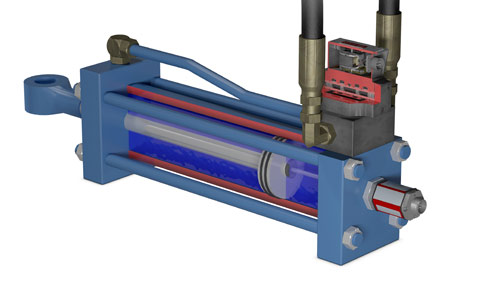
Positioning cylinders use a servovalve and an MDT position sensor for precision and speed. Below is a close-up image of the servovalve in use.
The valves needed to achieve only high-speed cylinder motion or high motor speed are not that sophisticated. In many cases they need only be large. If basic electrical on-off control is needed, then the valve may have a simple electric-to-hydraulic pilot stage. These components are referred to as solenoid-controlled, pilot-operated directional control valves.
If opening a large spool valve to suddenly direct a high flow to a cylinder or motor is too sudden of a shock, an adjustable flow control often referred to as a choke—located between pilot stage and main stage—helps to slow the rate of spool travel.
If a cylinder needs to begin moving without any delay after the valve has been signaled, then the valve design becomes more complex. The valve spool may have zero overlap or even an underlap to ensure good response. If the spool must still overlap the valve ports to guarantee periods without any cylinder drift, the valve control electronics will feature a deadband compensator to jump the spool to the open and flowing position quickly. Many of these features are common for proportional valves.
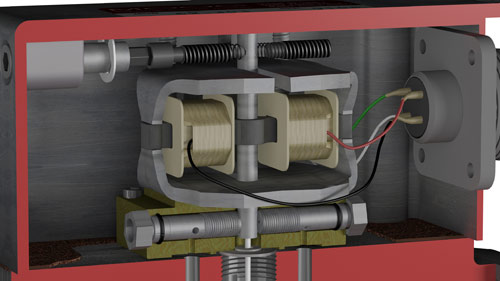 If all of the above valve features do not provide sufficient performance and response time and if preventing a cylinder position-overshoot becomes important, a true hydraulic servovalve is needed. The valve will typically be mounted on the cylinder where a magnetostrictive displacement transducer (MDT) has also been installed.
If all of the above valve features do not provide sufficient performance and response time and if preventing a cylinder position-overshoot becomes important, a true hydraulic servovalve is needed. The valve will typically be mounted on the cylinder where a magnetostrictive displacement transducer (MDT) has also been installed.
Moving a heavy load quickly to a precise position and then stopping instantly is a requirement that makes hydraulics—with its stiff fluid medium—more suitable than pneumatics. Stopping the cylinder motion in exactly the right place is still tricky enough to require position measurement from the MDT and a complete closed-loop control system for the servovalves.
Cylinders
Cylinders for high-speed applications need to chosen carefully. The tube must be honed and finished with great care. The piston seals must be suitable for high speeds and offer low friction.
In the case of the stack hoist cylinder that just has one high-speed motion, during full rod length extension, an adjustable cushion on the rod end will minimize shock and help keep the piston from being broken from the rod.
Regeneration on the hoist extend motion reduces the cylinder’s force capabilities because there is near equal pressures on both sides of the piston. This means that the rod diameter—or more precisely, the ratio of rod side piston to blind side piston surface area—is an important design decision.
High-speed motors
In the plywood and engineered flooring product plant, flying circular saws that trim the panels as they move along the line often require the most compact prime movers. Hydraulic motors are sometimes chosen over electrical motors. Special model series of hydraulic motors rated for shaft speeds of 5,000 to 7,500 rpm help achieve the required saw speed for a clean finish cut. These motors feature carefully machined ports and internal parts with bearings and seals designed for the high shaft speeds.
Fittings, hoses and tubing
For systems that feature high flow rates, keeping elbow fittings to a minimum is key to minimizing flow turbulence. Turbulence will cause increased pressure drops through the system plumbing and will reduce energy efficiency among other negative effects. The use of wide radius hose bends and bent tubing for 90° plumbing is greatly preferred.
Taking the time to consult with hose and tubing vendors regarding proper diameters for hoses and the internal finishes of hoses and tubing minimizes friction and inefficiency.
Maintaining high-speed industrial hydraulics
Maintenance requirements for high-flow and high-speed hydraulic systems may require more attention paid to the maintenance of accumulators if they are used to boost flow rates. Gas precharge pressures may need to be checked more frequently.
The use of electrohydraulic proportional or servovalves for high-speed positioning cylinders demands extra vigilance over the condition of the fluid with careful monitoring of the particle count. Servovalves feature some of the tightest internal clearances and demand the highest levels of fluid cleanliness to maintain reliability and long life. An industrial fluid analysis lab can be a valued maintenance partner.
Cylinders that cycle often and move large masses may need mount bolts as well as tie rod torque values checked with greater frequency. Valve control adjustments are often commonly made to servo-positioning systems in factories where product parameters and production demands change. Keeping a watchful eye for any axis of motion that makes a heavy thud as the cylinder stops at a precise position might require some additional valve signal tuning to keep these shocks from damaging the cylinders.
In the overall analysis of high-speed industrial hydraulics applications in industry, the systems still consist of pumps, valves and actuators like any other. High flows, high cycle rates and high-speed cylinder motions simply mean attention to the unique design requirements and more frequent checks for fluid quality and proper functioning of the system components.
CD Industrial Group
carldyke.com
LunchBoxSessions.com
Filed Under: Fluid Power Basics, Fluid Power World Magazine Articles, Pumps & Motors

